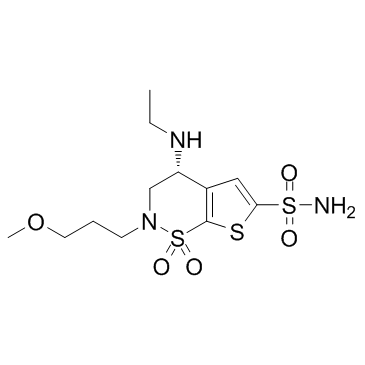(4R)-4-(ethylamino)-2-(3-methoxypropyl)-1,1-dioxo-3,4-dihydrothieno[3,2-e]thiazine-6-sulfonamide,hydrochloride
Modify Date: 2024-01-12 00:42:28
![(4R)-4-(ethylamino)-2-(3-methoxypropyl)-1,1-dioxo-3,4-dihydrothieno[3,2-e]thiazine-6-sulfonamide,hydrochloride Structure](https://www.chemsrc.com/caspic/248/150937-43-2.png)
(4R)-4-(ethylamino)-2-(3-methoxypropyl)-1,1-dioxo-3,4-dihydrothieno[3,2-e]thiazine-6-sulfonamide,hydrochloride structure
|
Common Name | (4R)-4-(ethylamino)-2-(3-methoxypropyl)-1,1-dioxo-3,4-dihydrothieno[3,2-e]thiazine-6-sulfonamide,hydrochloride | ||
|---|---|---|---|---|
| CAS Number | 150937-43-2 | Molecular Weight | 419.96800 | |
| Density | N/A | Boiling Point | 586ºC at 760 mmHg | |
| Molecular Formula | C12H22ClN3O5S3 | Melting Point | N/A | |
| MSDS | N/A | Flash Point | 308.2ºC | |
Use of (4R)-4-(ethylamino)-2-(3-methoxypropyl)-1,1-dioxo-3,4-dihydrothieno[3,2-e]thiazine-6-sulfonamide,hydrochlorideBrinzolamide (AL-4862) hydrochloride is a selective carbonic anhydrase II inhibitor with anIC50 value of 3.2 nM. Brinzolamide hydrochloride reduces intraocular pressure (IOP) by inhibiting ciliary CA-II and decreasing atrial fluid secretion. Brinzolamide hydrochloride can be used in glaucoma disease research[1][2]. |
| Name | (4R)-4-(ethylamino)-2-(3-methoxypropyl)-1,1-dioxo-3,4-dihydrothieno[3,2-e]thiazine-6-sulfonamide,hydrochloride |
|---|---|
| Synonym | More Synonyms |
| Description | Brinzolamide (AL-4862) hydrochloride is a selective carbonic anhydrase II inhibitor with anIC50 value of 3.2 nM. Brinzolamide hydrochloride reduces intraocular pressure (IOP) by inhibiting ciliary CA-II and decreasing atrial fluid secretion. Brinzolamide hydrochloride can be used in glaucoma disease research[1][2]. |
|---|---|
| Related Catalog | |
| Target |
IC50: 3.2 nM (carbonic anhydrase II)[2]. |
| In Vivo | Brinzolamide (7.5 mg or 12 mg) hydrochloride implanted in a silicone matrix is extremely well tolerated and provides sustained release of brinzolamide and significant reduction in intraocular pressure (IOP) for up to 28 days with no adverse effects or signs of toxicity in normotensive NZW rabbits[2]. The pharmacokinetic parameters of Brinzolamide hydrochloride in rabbits[1]. Intracameral Administration (4.5 mg) Intracameral Administration (4.5 mg) Topical Administration (500 mg) Topical Administration (500 mg) PK Parameters Aqueous Humor Iris-Ciliary Body Aqueous Humor Iris-Ciliary Body Tmax (h) 0.08 0.5 1 0.25 Cmax (ng/mL, ng/g) 11,050 1964 408 1245 Terminal t1/2 (h) 3.4 13 2 13.6 AUC0-24h (h*ng/mL, h*ng/g) 17,780 7725 1896 11414 AUC0-∞ (h*ng/mL, h*ng/g) 17,836 8839 1955 16628 Dose-normalized AUC0-∞ (h*/mL, h*/g) 4 2 0.004 0.03 Animal Model: Rabbits[2] Dosage: 7.5 mg, 12 mg Administration: Brinzolamide silicone matrix implant placed in the episcleral space Result: Resulted in a significant IOP reduction of 4.6 mmHg on days 10-28, with concentrations of 12 mg. |
| References |
| Boiling Point | 586ºC at 760 mmHg |
|---|---|
| Molecular Formula | C12H22ClN3O5S3 |
| Molecular Weight | 419.96800 |
| Flash Point | 308.2ºC |
| Exact Mass | 419.04100 |
| PSA | 163.80000 |
| LogP | 4.07960 |
| Vapour Pressure | 1.03E-13mmHg at 25°C |
|
~97% ![(4R)-4-(ethylamino)-2-(3-methoxypropyl)-1,1-dioxo-3,4-dihydrothieno[3,2-e]thiazine-6-sulfonamide,hydrochloride Structure](https://www.chemsrc.com/caspic/248/150937-43-2.png)
(4R)-4-(ethylam... CAS#:150937-43-2 |
| Literature: Duke Chem, S. A. Patent: EP1985618 A1, 2008 ; Location in patent: Page/Page column 11 ; |
| Precursor 1 | |
|---|---|
| DownStream 1 | |
| Azopt Hydrochloride |
| UNII-N36YTS80H4 |
| AL-4682 Hydrochloride |
| Brinzolamide Hydrochloride |
![(R)-4-(N-acetyl-N-ethylamino)-3,4-dihydro-2-(3-methoxypropyl)-2H-thieno[3,2-e]-1,2-thiazine-6-sulfonamide-1,1-dioxide structure](https://www.chemsrc.com/caspic/098/1072782-87-6.png)
 CAS#:138890-62-7
CAS#:138890-62-7